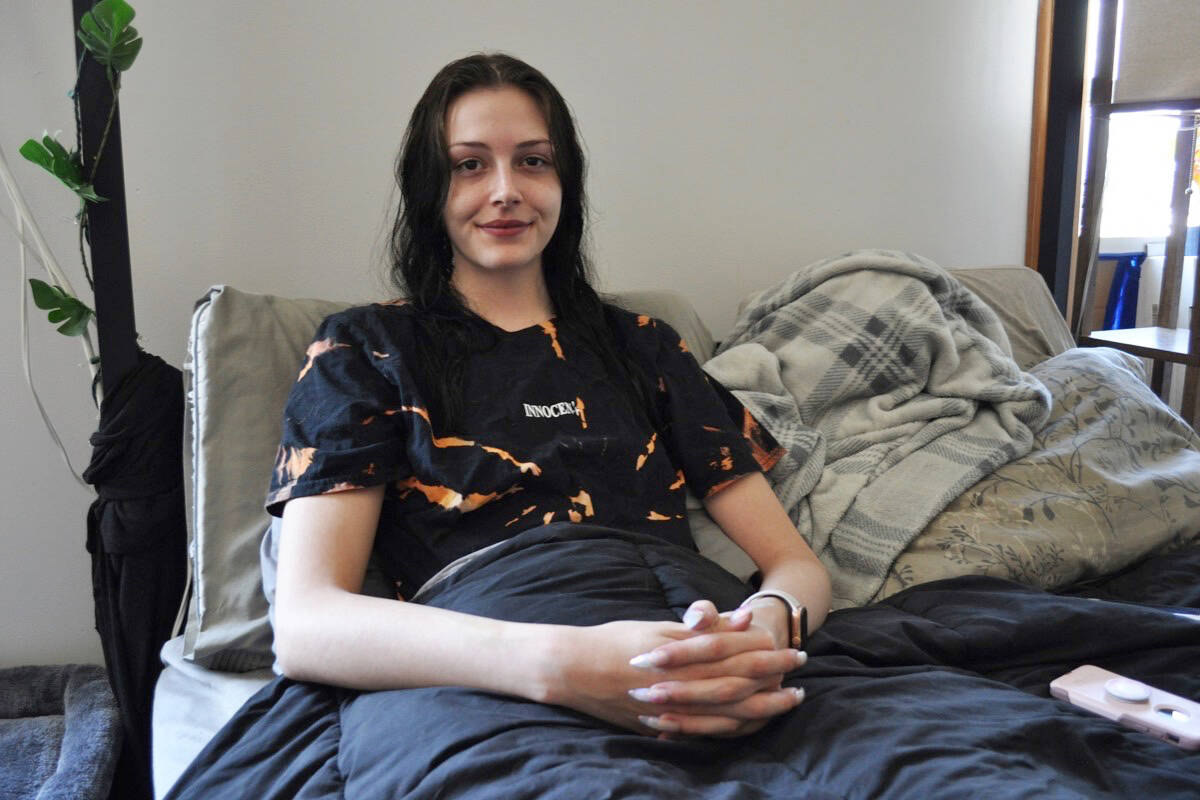From her bed, Auraya Marshall listens alone to the sound of traffic below her apartment window. The Nelson mall she used to work at is just a block away, the beach a short walk from her apartment, but those places have become abstractions to her.
Marshall���߲��о����s reality is a small apartment where the daily excitement is whether or not she can make it to her washroom without suffering an injury. She���߲��о����s just 23 years old and imprisoned by her body.
���߲��о����I look at the outside world and it seems like such a far thing to get to.���߲��о����
Marshall lives with Ehlers-Danlos syndrome (EDS), a rare genetic disorder that weakens the connective tissues in her tendons and ligaments. The Ehlers-Danlos Society says the condition���߲��о����s prevalence varies depending on which of the 13 variations a person has, but that it can present in anywhere from 1 in 3,500 people to less than one in a million. There is no current estimate for the number of Canadians living with EDS.
EDS affects collagen, the protein that gives tendons, bones and skin their strength. Without sufficient collagen, the body becomes a house of cards prone to falling apart at the slightest touch. It���߲��о����s a painful, debilitating disease with no cure.
At home, Marshall spends her time confined to a bed while her partner is at work. She has two cats, one of them a three-month-old kitten named Bliss who plays nearby, and a phone to keep her occupied. Otherwise, she tries to stay prone, staring at the white ceiling above.
She had health issues growing up ���߲��о���� Marshall recalls complaining about joint pain as a child ���߲��о���� but wasn���߲��о����t diagnosed with EDS until she was 16. That year she developed an ulcer and was hospitalized for two months with severe stomach issues, which can impact people with EDS and now forces her to live on a diet of mostly fluids or soft foods.
Still, Marshall managed with visits to a chiropractor and a minimum dosage of painkillers. She worked at a clothing store, and when the COVID-19 lockdown began she used the time off to complete her high school diploma equivalency. She modelled for an American magazine and discovered a passion for DJing. Last year she even had the strength to hike up to Pulpit Rock overlooking Nelson.
���߲��о����I used to live quite a life and move around. ���߲��о���� I was still able to go about the day-to-day life and have the energy.���߲��о����

But in October 2021, Marshall was walking at a local park with a friend when she slipped and broke her arm. As she recovered at home, she gradually lost the muscle strength she had built up with daily physiotherapy exercises meant to overcompensate for her weak ligaments.
She���߲��о����s now been essentially bedridden since January. She can���߲��о����t stand for longer than a couple of minutes without fainting and lives in fear of dislocating her neck, spine and hips. Two weeks ago, she said her spine was dislocated in five or six places.
���߲��о����I could stand up and go to the bathroom and I could dislocate my joints or something and then be in excruciating, like a level 10 kind of pain until I can get to a chiropractor to get it back together.���߲��о����
Marshall describes EDS as an ���߲��о����invisible disability���߲��о���� that has no visual markers, which can lead people to think she is healthy. She says she���߲��о����s gone out with a wheelchair and in a neck brace in the past and been accused of faking her condition, the memory of which causes her to well up.
It also doesn���߲��о����t happen often, because typical wheelchairs are designed to be powered by upper-body strength. Marshall no longer has that.
���߲��о����I will just dislocate my spine trying to move a wheelchair. I have to have a power unit and then even the bumps can be scary.���߲��о����
Earlier this month, one of Marshall���߲��о����s friends set up a for her and her partner. Marshall has no family support of her own. At age 12 she was placed into foster care, left three years later because she felt unsafe and has been providing for herself ever since.
She receives income assistance and is in the process of applying for the federal disability benefit, but doesn���߲��о����t have the money for comforts that might improve her standard of life such as an electric wheelchair.
Those needs have outweighed her desires, like a laptop for making music again, or even the prospect of post-secondary education, which she calls ���߲��о����a pipe dream at this point.���߲��о����
Rejoining the world will mean Marshall has to learn to live with Ehlers-Danlos syndrome. She just hasn���߲��о����t figured out how yet, because her body won���߲��о����t let her.
If you���߲��о����d like to make a donation to Marshall, visit .
READ MORE:
���߲��о����
���߲��о����
���߲��о����
| tyler.harper@nelsonstar.com
Like us on and follow us on .



